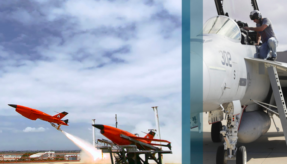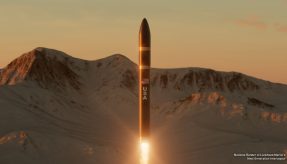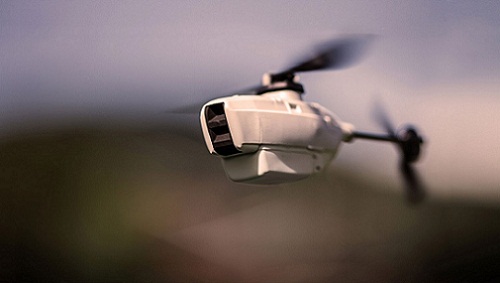
Unmanned systems, whether aerial, land-based or marine, are taking the defence marketplace by storm, their remote technology allowing intelligence to be collected and transmitted from warzones without risking lives. Yet with this power come ethical and commercial challenges, as Plextek’s Defence Business Manager Peter Doig explains in this interview with MOD DCB features editor Julie Shennan.
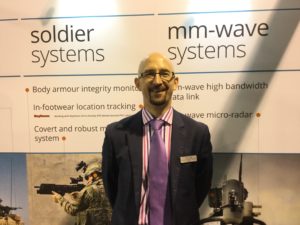
Peter Doig
Founded in 1989, Plextek is an electronics consultancy that specialises in creating solutions to overcome complex engineering challenges. Since its early days the company has gained a foothold in a range of sectors including healthcare, smart sensors, security and defence.
Plextek’s Defence Business Manager, Peter Doig, explained: “Plextek has had relationships with a small number of leading defence companies for about two decades, becoming a highly trusted technology supplier. In recent years we have been expanding our research significantly into securing business directly with government via the Ministry of Defence and the Defence Science and Technology Laboratory (Dstl).”
Recently Plextek collaborated with Dstl on a low Size, Weight, Power and Cost (SWaPC) non-line-of-sight communications system for Small Unmanned Air Systems (SUAS) via the Autonomous Systems Underpinning Research (ASUR) programme. The system operates at 60 GHz, where the radio frequency wavelength is 5 mm.
Launched in 2013, the £10 million ASUR programme is due to run until 2017 researching, developing and deploying intelligent unmanned systems into the UK Armed Forces.
Mr Doig commented: “At the moment Plextek is developing two SUAS-related projects in conjunction with Dstl on the ASUR programme. Both projects are leveraging millimetre wave (mm-wave) consumer electronics – the first, developing a high bandwidth, robust data link to provide non-line-of-sight, covert communications to SUAS to enable, for example, streaming of high-definition video to a soldier in a complex urban environment.
“The second project uses the same underlying technology to develop an mm-wave micro-radar as a day/night, all-weather sense-and-avoid imaging sensor. This project aims to enable an SUAS to autonomously travel down an urban canyon or into a building, interpreting the world in real time.”
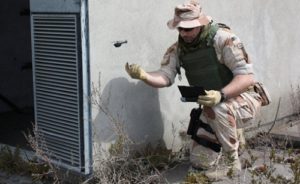
Nano Drone :Black Hornet
These projects will be suitable for both a mini and a micro SUAS, and potentially Nano Unmanned Aerial Vehicles. They work by enabling technology for a 60 GHz radio frequency (RF) data link between an operator and an SUAS.
60 GHz is strongly reflected by most surfaces and able to penetrate deeply into a building, essentially following the same route as an SUAS which has infiltrated the building. 60 GHz transmission is also inherently covert because the oxygen absorption line at this frequency reduces the scope for detection at longer ranges.
The 60 GHz RF data link will be enabled by a single-chip solution based on silicon-germanium technology, addressing both mm-wave RF and baseband modem requirements.
These solutions are low cost, relatively low power consumption and light in weight. The modem technology Orthogonal Frequency-Division Multiplexing (OFDM) is well suited to difficult propagation conditions such as indoor channels with many multipath elements, and offers a high data throughput suitable for video transmission.
To enable data transmission the SUAS needs a suitable antenna solution, something which the communications project has demonstrated. It is necessary to achieve significant antenna gain at both ends of the link in order to meet the requirements of the link budget. This means utilising a narrow (highly directional) beam, and for the mobile SUAS application, with antennas constantly optimising beam-direction. Plextek is currently working with Dstl to develop and demonstrate a low (SWaP) micro-radar solution.
Once fully developed, the SUAS technology also has the potential to be migrated into other unmanned air systems, unmanned ground vehicles and even dismounted soldier equipment.

Mr Doig explained: “Dismounted soldiers are always looking for greater situational awareness; Plextek’s mm-wave data link will enable HD video to be streamed between soldiers, while the micro-radar will allow them to expand the understanding of their surroundings.”
While physically developing technology for unmanned solutions, Plextek has also theoretically debated the issue in a paper titled ‘Are the Days of the Soldier Numbered?’
Mr Doig said: “This paper discusses the changing battlefield environment, having moved from the desert warfare of the 1990s back into urban warfare. Within this environment, we are looking at how unmanned systems and autonomous systems can provide soldiers with remote information and make their work more efficient.”
He added: “Despite the title of the paper, its findings suggest that soldiers in the field will always be needed for interacting with local populations and judging risk. The paper also discusses the various unmanned system regulations, such as those within the Geneva Convention, which stop an autonomous system from being able to make decisions such as whether or not to engage with a threat.”
The paper is now available via Plextek’s website and the company is seeking feedback from both defence industry stakeholders and academics.
Engagement with academia is, Mr Doig stressed, important to all defence manufacturers. As well as building relationships, academic partnerships help defence manufacturers accelerate their product through the research and development cycle.

SHARC at Unmanned Warrior 2016
He expanded: “The last couple of years have seen a shift in defence research spend patterns toward more disruptive technology research; this can lead to greater rewards but can be a difficult medium for which to write a compelling proposition. One of the factors the MOD looks for in business proposals is commercial exploitation, and it can be difficult to find commercial exploitation partners for high-risk projects.
Mr Doig continued: “To overcome these obstacles suppliers should look to engage with academia and Dstl direct. For example, Dstl has research engagement with UK universities that small and medium-sized enterprises (SMEs) can use to their advantage to secure defence funding.”
Once through the door of the defence marketplace suppliers must then find extra funds to see their project through to completion – or perish in the proverbial ‘valley of death’ that so often separates the research stage from the development stage.
Mr Doig said: “A lot of the time when bringing commercial off-the-shelf (COTS) technology into a defence environment it can quickly reach a high technology readiness level; however, from a system readiness perspective, it can still require a lot of work. The MOD is unable to fund all of the development work required, so Original Equipment Manufacturers (OEMs) and System Integrators need to pull on this research and help develop it further.”
As a Tier 1 (a company that is directly contracted by an OEM), Plextek itself is able to help smaller companies into the defence marketplace.
Mr Doig recalled: “Over the past few years we have delivered over twenty projects into the Centre for Defence Enterprise (CDE). During a number of these projects we have worked with academic partners and scientific research institutes, in addition to a micro-SME, who had an idea that they were unable to implement themselves; so with the breadth of our engineering services we were able to successfully deliver a concept demonstrator.”

Wave foil technology demonstrated at Unmanned Warrior
Plextek continues to partner with small businesses, helping them engage with the wider industry and access different funding routes.
Mr Doig clarified: “Plextek seeks innovation and trust in its supply chain partners. We need our partners to understand that to be successful in the defence marketplace can take years of hard slog. Defence is a complex marketplace; the different funding streams mean that you can win your first seed-funding project within three months, but to secure a large development can take 18 to 48 months.”
He concluded: “Newcomers need to engage with the MOD as much as possible. There are lots of open, public events that then lead to more closed-shop events; these smaller events can boost suppliers’ ability to engage with stakeholders and meet their requirements.”
If you would like to join our community and read more articles like this then please click here
Armed Forces ASUR DCB Nano Unmanned Aerial Vehicles Peter Doig Plextek SUAS UAVs unmanned




